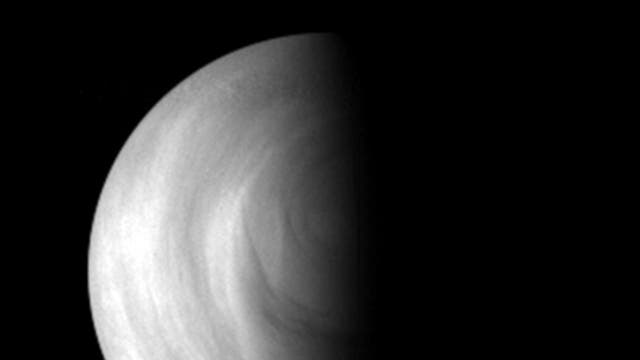In a surprising find, scientists have discovered a cold layer sandwiched between two hot ones in Venus atmosphere, the hottest planet in the solar system. The said layer is so cold, that carbon dioxide freezes over and falls down on the surface as ice or snow.

This 2006 Venus Express image shows the day and night sides of Venus. Credit: ESA
Popular astronomical conception has Venus portrayed as Earth’s evil twin, a sort of hell to match with the serene paradise of our blue marble. A new study, capitalizing on five years worth of observational data, shows that the planet isn’t completely all scorching hot, as it describes a –175ºC cold atmospheric layer, located 125 kilometres above Venus’ surface.
“Since the temperature at some heights dips below the freezing temperature of carbon dioxide, we suspect that carbon dioxide ice might form there,” stated Arnaud Mahieux, who is the study’s lead author and also a researcher at the Belgian Institute for Space Aeronomy.
The discovery was made with the help of the European Space Agency’s Venus Express spacecraft that has been circling Venus for the last six years, taking pictures and sending back data from the planet. The satellite probed the hot planet’s atmosphere and looked on how light from the Sun is filtered through the atmosphere. This revealed the concentration of carbon dioxide gas molecules at various altitudes along the terminator – the dividing line between the day and night sides of the planet. Having measured another state parameter, pressure, at various altitudes, the scientists had enough data to establish temperature.
As it wasn’t enough that the established cold atmopsheric layer is located in between two warm layers, apparently it’s also colder than any other layer found in Earth’s atmosphere, despite Venus being 40 million kilometres closer to the sun. Previously, the Venus Express satellite saw bright patches in the atmosphere, which now scientists believe might actually be bits of ice or snow falling from this cold spot. Still, Mahieux warned there could be other explanations for this phenomenon.
“They could also be caused by other atmospheric disturbances, so we need to be cautious,” he stated in a press release.
The results will be published in the Journal of Geophysical Research.









